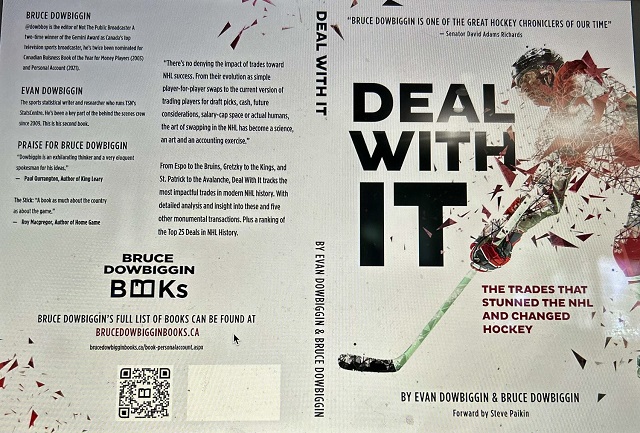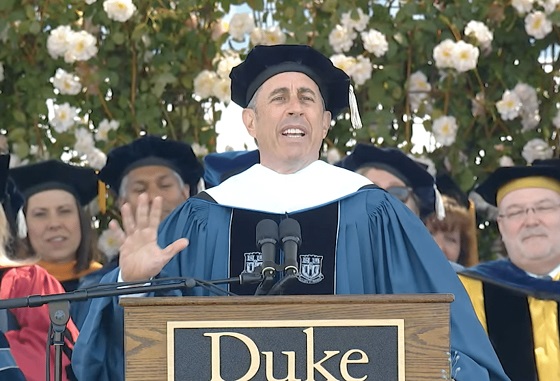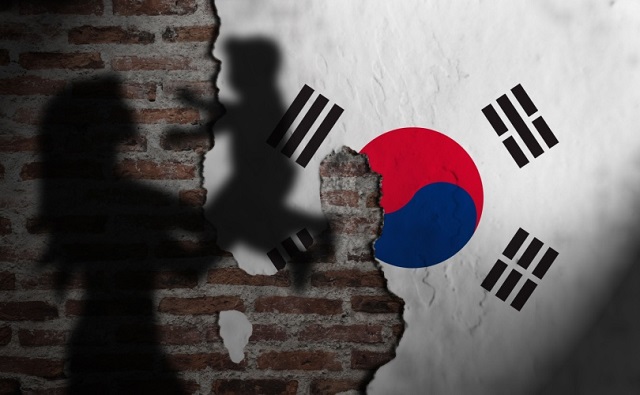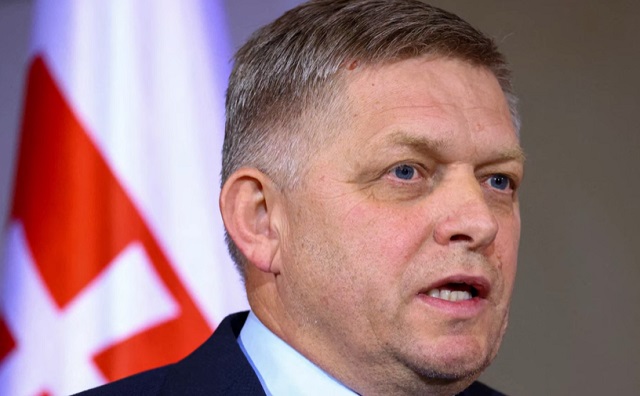Bruce Dowbiggin
Deal With It: When St. Patrick Talked His Way Out Of Montreal

Coming soon, our latest book “Deal With It: The Trades That Stunned The NHL And Changed Hockey”. With my son Evan, we look back to Espo to the Bruins (1967), Gretzky to the Kings (1988) , and St. Patrick to the Avalanche (1995), Deal With It tracks the back story behind the most impactful trades in modern NHL history. With detailed analysis and keen insight into these and five other monumental transactions, Deal With It recalls the moments when history was changed. Plus a ranking of the Top 25 Deals in NHL History.
One of the most memorable occurred 24 years ago, on December 6, 1995: Patrick Roy and Mike Keane from the Montreal Canadiens to the Colorado Avalanche for Jocelyn Thibault, Martin Rucinsky and Andrei Kovalenko. Trading, arguably, the greatest goalie the Canadiens history was the culmination of organizational dysfunction from which it has yet to recover. It begins with the hiring of former Habs Mario Tremblay and Rejean Houle when the Canadiens stumbled entering the 1994-1995 season. It started off well. Then on a November night in Montreal…
“With the team cooling off from their torrid start under (Mario) Tremblay, the Habs were at home for a Saturday night affair hosting a powerful Red Wings team on its way to breaking the NHL single-season wins record set by the 1976-77 Montreal team (62 to that club’s 60). With the closing of the Forum, the arena Roy had once dominated, Patrick’s dominance had become less-than-surefire. (He came in that night at 238-80-34 all-time at the Forum.) All that rich history didn’t help Roy that particular night and before a national TV audience the wheels came off for hundreds of thousands to witness.
Earlier in the day, Roy had had an impromptu breakfast at Moe’s Diner in Montreal with Detroit goalie Mike Vernon, who’d himself been forced out of Calgary after winning a Cup. Roy described his predicament. “It might be time for you to ask for a trade,” Vernon suggested to him. Fast forward to the notorious game. Getting bludgeoned by the Wings attack, Roy had given up nine goals before the game hit its halfway mark. Getting mock cheers for one of his few saves on the night- prompted a seething Roy replied with mock acknowledgement to the crowd. Clearly overwhelmed, Roy was kept in the nets as Tremblay let his star goalie get roasted by Scotty Bowman, who enjoyed getting revenge on his former player Tremblay for some remarks he’d made about Bowman’s coaching style.
Finally hooked after the ninth marker, Roy glared menacingly at his coach as he walked by on the bench. Stopping to take care of more business, he walked back across and, face-to-face, told a distressed-looking Corey that he had just played his last game with the Canadiens. As Roy walked past Tremblay on his way to the end of the bench, Roy and Tremblay glared eye-to-eye. Roy told him in French, “You understand?” This very public moment overshadowed what remains the worst home loss in the club’s storied history, an 11-1 spanking from Detroit. TV highlights that night across North America showed the stare-down.“The whole city was talking about it,” recalled Montreal native Eric Engels. “The team had suspended Roy and said they were going to trade him, and I just remember saying to the bus driver that they didn’t have to go this way, that they could salvage the situation.”
The following days saw the controversy erupt even further. Just months after plucking Houle and Tremblay from outside the organization, Corey sided with his inexperienced newbies and told Roy he would be getting dealt even when Roy apologized for his spat and vowed to mend fences. Typical of the climate at the time for even superior players who “disrespected” the organization, Roy was persona non grata in a matter of days. In his book, Serge Savard: Forever Canadien”, Savard explained the inevitability of the deal: “Patrick had become too important in the club. He took up too much space in the dressing room, had too much influence on the coach. Over the previous years, I had to handle him with kid gloves. I still had the same admiration for him as I did when we won the Stanley Cup in 1986 and 1993, where he played a determining role. But a change had become necessary. The team revolved around him too much. For the good of everyone, he needed a change of scenery.”
Team captain Mike Keane didn’t help lower the temperature at the Forum by claiming the man who wore the “C” with the Canadiens didn’t necessarily need to speak French and that he wouldn’t be bothering to learn it because the dressing room mostly communicated in English (true even in the most predominately French-based Habs teams such as the 1993 Cup winner that boasted no less than dozen Quebecois). Both Keane and Roy would go on the trading block together, joining similarly exiled pieces like Chris Chelios and Guy Carbonneau (the captain of the ’93 Cup winner, dealt after 1993-94 to the Blues for Jim Montgomery, after flashing the middle finger to a photographer who had eavesdropped on him playing a round of golf). Carbonneau’s successor at captain, Kirk Muller— an Ontario boy through and through— expressed how honoured and proud he was to wear the fabled letter patch. But he, too, would find himself gone to the Islanders partway through 1994-95. In other words, almost no one was sacred in Ron Corey’s world. Only four days after his dressing-down of the team president and head coach, Roy was notified by Houle that he had been traded.
Just like that, Montreal had parted with its franchise goalie as if it were still the “Original Six” days and players that got in management’s crosshairs were expendable. How traumatic was the deal for the rookie GM Houle? He’ll never tell. “And that is what I intend to do forever so that I don’t have to look back at a time that was difficult for me.” As for Roy, his take was “It was clear from the organization that they had made their decision. I said, ‘Okay, I’ll accept my mistake.’ I agree I was the one who made that thing happen on that Saturday, and both parties agreed it was in the best interests of us that we go different directions. I understand that you can’t put ten years aside and give it a little tap and it’s all gone. I lived through lots of good things in Montreal, but, again, it’s a turn I accept.”
Bruce Dowbiggin @dowbboy is the editor of Not The Public Broadcaster A two-time winner of the Gemini Award as Canada’s top television sports broadcaster, he’s a regular contributor to Sirius XM Canada Talks Ch. 167. Inexact Science: The Six Most Compelling Draft Years In NHL History, his new book with his son Evan, was voted the seventh-best professional hockey book of all time by bookauthority.org . His 2004 book Money Players was voted sixth best on the same list, and is available via brucedowbigginbooks.ca.
Bruce Dowbiggin
Jerry Came to See The Babies. And They Walked Out On Him

Cometh the hour, cometh the comedian. Or, you can learn a lot about a demographic by what makes them laugh.
The legacy/ lunacy media schvitzed itself over a few furious sociology majors and look-at-me drama queens walking out on Jerry Seinfeld’s commencement address at Duke University last weekend. But the significance of his admission that he was 70 was probably far more newsworthy to those now in retirement, binge-watching his eponymous TV series on one of those down-the-dial channels.
If we had a dollar for every Boomer who said, “Seinfeld is 70?” while watching the address we’d be Warren-Buffett-rich this morning. He doesn’t look like any 70 year olds we know. Fifty? Maybe. But listening to his familiar delivery, the mocking on his honorary degree costume, it was easy to believe that we, too, are much younger than our blood-thinner prescriptions say.
It also pointed out the evolution of Boomers’ comedic tastes. When they came of age in the late 1960s/ early 1970s Woody Allen best profiled as his generation’s comedic muse. With a dozen classic movies ranging from What’s New Pussycat (1965) through Play It Again Sam (1972) to Annie Hall (1977) Allen’s self-deprecating nebbish captured the romantic/ridiculous self-image of Boomers with “Some drink deeply from the river of knowledge. Others only gargle”.

The neurotic, insecure Allen then decided to become Ingmar Bergman, and Boomers— now assembling jobs, children and first spouses— moved on. But for that 12-year span the bedraggled standup comedian was the go-to with lines like “Just because you’re paranoid doesn’t mean they aren’t out to get you” and “The only love that lasts is unrequited love.”
Woody’s pointed contemporary political references in those years were few (conflating “D’you” for “Jew” with Tony Roberts in Manhattan) and self-deflating (see Annie Hall). His most prominent political jabs were framed in absurdist material like Love And Death and Bananas. Culturally he was merciless but affectionate about his Brooklyn upbringing. In short his were perfect date movies for Boomers seeking love to advertise their pretensions.
Flash forward from Woody to Seinfeld (created with Larry David) which was anti-romantic in the extreme. The characters were sociopaths. The situations often cringeworthy. The 24-minute formula harkened back to Lucy and the Honeymooners. And while schlock like Friends trod the same ground it was Seinfeld that somehow captured the Boomer zeitgeist.
Why? Boomers going through middle age were too disillusioned with how life was turning out to romanticize anymore. The self-obsessed characters were people they knew from work, school and dealing with government. Smirking Bill Clinton was the face of an era. “When we did my show in the 90s, it was so easy to make fun of things. It was so easy,” Seinfeld told Amy Schumer.
Significantly, Seinfeld the Show was cultural. Or quasi-cultural. It was never about politics per se. It was about the people who thwart you in life. Whose vanity ruins your plans from school days. Who go 50 mph in the left lane. “When is Jerry going to see the baby?” It rarely challenged its fans on an emotional level. It was mostly about navigating madness.
And often about the most mundane elements of life. The address on the weekend contained The Seinfeld Doctrine of Lowered Expectations. “It’s easy to fall in love with people. I suggest falling in love with anything and everything, every chance you get. Fall in love with your coffee, your sneakers, your blue zone parking space. I’ve had a lot of fun in life falling in love with stupid, meaningless physical objects.
“The object I love the most is the clear-barrel Bic pen — $1.29 for a box of 10. I can fall in love with a car turn signal switch that has a nice feel to it, a pizza crust that collapses with just the right amount of pressure. I have truly spent my life focusing on the smallest things imaginable, completely oblivious to all the big issues of living.”
Reaching across the generations Seinfeld delivered Dad jokes and bromides to kids who education probably cost $100 K a year. “I think it is also wonderful that you care so much about not hurting other people’s feelings in the million and one ways we all do that,” he said. Then he explained why that might be a fruitless pursuit. Not in Curb Your Enthusiasm darkness. But sobering.
That’s why it was in character for him to let the furious demonstrators depart at Duke without comment. So was appearing at Duke, the Ivy League of Tobacco Road, founded by the people who made jillions selling nicotine. And why he let them garb him like Thomas Cromwell in the absurd 16th century cape and hat so he could score few laughs.

Because laughter is his means of dealing with jerks like the outbound Hamas crowd. “What I need to tell you as a comedian: Do not lose your sense of humour. You can have no idea at this point in your life how much you are going to need it to get through. Not enough of life makes sense for you to be able to survive it without humour.”
Yes, He has been vocal lately about the effect of political correctness ruining TV comedy. Drawing flak from former friends and fans who are in the Biden re-education camps at the moment. But his annoyance at ruining an art form far outweighed any complaints about Covid and Ukraine.
As opposed to the nihilism of his former partner David, his insouciance and comic patter represent an antidote for where most of his original fans are at the moment. Woody Allen, their former idol, is now seen as a pedo and a failed nouveau vage auteur. Disillusioned with virus lies, electoral shenanigans and soaring prices, Boomers on a pension are unanchored, floating through what used to be North American society (when only women had babies).
In fact, Boomer spectators watching Seinfeld’s 17-minute speech maybe summed it up for themselves by recalling the Seinfeld mantra, “It was a show about nothing.” And they’d be right. Jerry is the man for those times.
Bruce Dowbiggin @dowbboy is the publisher of Not The Public Broadcaster A two-time winner of the Gemini Award as Canada’s top television sports broadcaster, he’s a regular contributor to Sirius XM Canada Talks Ch. 167. Now for pre-order, new from the team of Evan & Bruce Dowbiggin . Deal With It: The Trades That Stunned The NHL & Changed Hockey. From Espo to Boston in 1967 to Gretz in L.A. in 1988 to Patrick Roy leaving Montreal in 1995, the stories behind the story. Launching in paperback and Kindle on #Amazon this week. Destined to be a hockey best seller. https://www.amazon.ca/Deal-Trades-Stunned-Changed-Hockey-ebook/dp/B0D236NB35/
Bruce Dowbiggin
Why Do The Same Few Always Get The Best Sports Scoops?

The Toronto Maple Leafs made the “what colour is that green light?” decision to fire their head coach Sheldon Keefe last week. The removal of Keefe after five years followed a dispiriting first-round playoff series loss to a very ordinary Boston Bruins team. Coaching may or may not have been the root cause of that loss. (Keefe himself admitted “teams are waiting for the Leafs to beat themselves”.)
The real reason for the firing is 1967, and we don’t think we need add more than that.
In essence, the management of MLSE— the owner of the Maple Leafs and a lot of other sports stuff in Toronto— needed to throw a body to the baying hounds of disappointment. Also known as Leafs Nation. Newly minted CEO Keith Pelley, fresh from the PGA Tour/ LIV psychodrama, was certainly not going to pay the price.
Nor was GM Brad Treliving who has only been on the job for two seasons. The key decisions on Toronto’s lopsided salary cap were decided long before Treliving occupied his desk. That left two people in vulnerable positions. 1) Maple Leafs president Brendan Shanahan, who has been drawing an MLSE cheque for a decade. 2) Keefe.
When was the last time you saw a coach fire a team president? Precisely. Keefe joins the list of (briefly) unemployed coaches who circulate in the NHL like McKinsey consultants. Shanahan gets a lukewarm mulligan from Pelley. But after the failure of the Kyle Dubas experiment— “who needs experience?”— and now just a single playoff series win in a decade Shanny’s best-before date has arrived.

Toronto Maple Leafs president Brendan Shanahan attends a news conference in Toronto on April 14, 2014. Toronto Maple Leafs president Brendan Shanahan said Peter Horachek will remain the team’s interim head coach until the end of the season. Shanahan met the media Friday for the first time since coach Randy Carlyle was fired on Tuesday. THE CANADIAN PRESS/Chris Young
Depending on who he and Treliving enlist to coach— remember, Mike Babcock was too tough and Keefe was probably too player friendly— it had better produce instant results. Because Shanny, the pride of Mimico, is out of chances. The coach choice will also be affected by whichever player or players that management decides are superfluous to ending the Leafs’ ridiculous run of misery.
The Leafs brass’ press conference last Thursday did little to shed light on what happens after Keefe’s expulsion. Just a lot of MBA determinism on a bed of baffle gab. A crabby Steve Simmons question/rant briefly threatened the harmony of the moment, but order was restored. And the media bitching switched from the press box to social media and podcasts.
Speaking of the fourth estate, the other unmentioned aspect of this story— indeed every story in the NHL these days— is just how it was revealed to the public. When people sipped their morning Tim’s or Starbucks the (almost) coincident bulletins came down the social media pike about Keefe’s dismissal.
Predictably, Chris Johnston of Sportsnet and Daren Dreger of TSN announced the breaking news within heart beats of each other. While there had been speculation on Keefe’s fate for days, the announcement coming from the networks duo confirmed the story in the minds of the industry. That allowed everyone else drawing a cheque as a hockey journalist to pile in and swarm the dead body.
In today’s sports journalism, where social media has replaced newspapers, scoops are governed by a protocol. There are the heralds— in the NHL it’s currently Johnston and Dreger— and then there are the disseminators. The days of a rabble of reporters all scrambling to get a story bigger than who-will-play-in-tonight’s-game are gone. Today, it’s a very narrow funnel for scoops.
It’s the same in the NFL where Ian Rappaport (NFL Network) and Adam Schefter (ESPN) monopolize the tasty scoops on behalf of their employers, who also happen to be NFL rights holders. In the NBA, Brian Windhorst (ESPN) has the inside rail when it comes to the LeBron James/ Steph Curry scoops. In MLB… it’s probably Ken Rosenthal (The Athletic) but no one cares about baseball anymore, do they?
The leagues like it this way, doling out stories to guys they can trust. None of this is criticism of Johnston or Dreger, who have deftly maneuvered themselves into the coveted “from their lips to your ears” spots. From our own experience we can remember the exhilaration of having the best source or sources on the really big stories. Like Johnston/ Dreger, we worked hard for a long time to develop those sources and only very reluctantly let anyone else horn in on our stories.
It was also our observation that this order of things journalistic suited a lot of reporters who either couldn’t get good sources or didn’t want the stress of being first on stuff. It was enough that, like the Keefe story, they’d get the goods eventually and most fans would not care who was first. So long as you had a take. So be it.
Some resentful types took potshots at our work if it upset their pals in the dressing room or the management suite. On the Stephen Ames/ Tiger Woods story in 2001, we had the late Pat Marsden tell us on air that we’d done a great job on Ames’ criticisms of Tiger. Only to hear him lambaste us— again on FAN 590— only minutes later as we listened driving home from the studio. But we digress.
Many reporters are complacent in playing the game, so long as their bosses didn’t enquire why they are getting scooped all the time by the same few rivals. With the death of daily newspapers that doesn’t happen much any longer. (Many editors today may only see stories when publication brings a libel notice.) For them a salty take is good enough.
The scoop business is also affected by the multiple roles now demanded of sports media types. In addition to their “day job” on a beat they also have to supply digital content and talk-back hits to the Mother Ship. Most also are feeding a weekly podcast, dictating time on air rather than time working the phone. There are only so many hours in a day to chase a story.
Better to play the Breaking News waiting game.
Bruce Dowbiggin @dowbboy is the publisher of Not The Public Broadcaster A two-time winner of the Gemini Award as Canada’s top television sports broadcaster, he’s a regular contributor to Sirius XM Canada Talks Ch. 167. Now for pre-order, new from the team of Evan & Bruce Dowbiggin . Deal With It: The Trades That Stunned The NHL & Changed Hockey. From Espo to Boston in 1967 to Gretz in L.A. in 1988 to Patrick Roy leaving Montreal in 1995, the stories behind the story. Launching in paperback and Kindle on #Amazon this week. Destined to be a hockey best seller. https://www.amazon.ca/Deal-Trades-Stunned-Changed-Hockey-ebook/dp/B0D236NB35/
-

 Automotive1 day ago
Automotive1 day agoGovernments in Canada accelerate EV ‘investments’ as automakers reverse course
-

 Health24 hours ago
Health24 hours agoSouth Korean president declares low birth rate a ‘national emergency,’ plans new ministry to address it
-

 COVID-192 days ago
COVID-192 days agoJapan’s most senior cancer doctor: COVID shots are ‘essentially murder’
-

 Economy1 day ago
Economy1 day agoBiden signs suicidal ‘No Coal’ pact, while rest of world builds 1,000 new plants
-

 conflict16 hours ago
conflict16 hours agoWhite House Reportedly Worried About Russia’s Sudden Momentum Months After Biden Declared Putin ‘Already Lost’ War
-

 Crime17 hours ago
Crime17 hours agoSlovakian prime minister who opposed WHO Pandemic Treaty shot in assassination attempt
-

 Alberta21 hours ago
Alberta21 hours agoFortis et Liber: Alberta’s Future in the Canadian Federation
-

 Health23 hours ago
Health23 hours agoUK pediatrician who led review of child ‘transitions’ says US medical groups ‘misleading the public’






